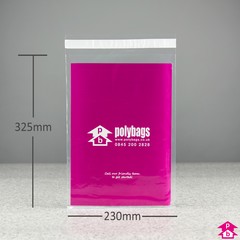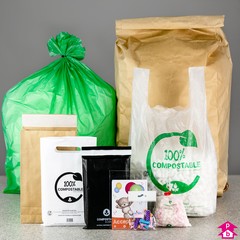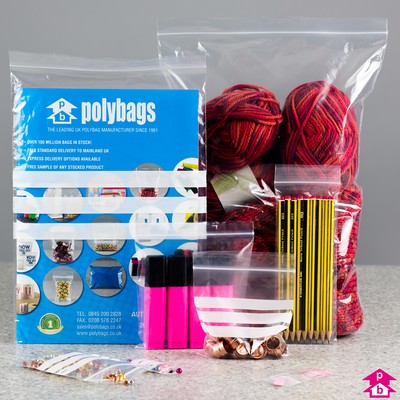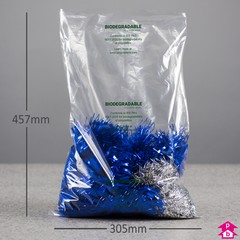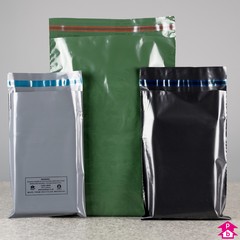230mm wide x 325mm long, 37.5 micron thickness (C4 for A4)
From £37.37 per 1000
- 100% recycled
- Biodegradable
- Carbon neutral
- Compostable
- Recyclable
- Renewable
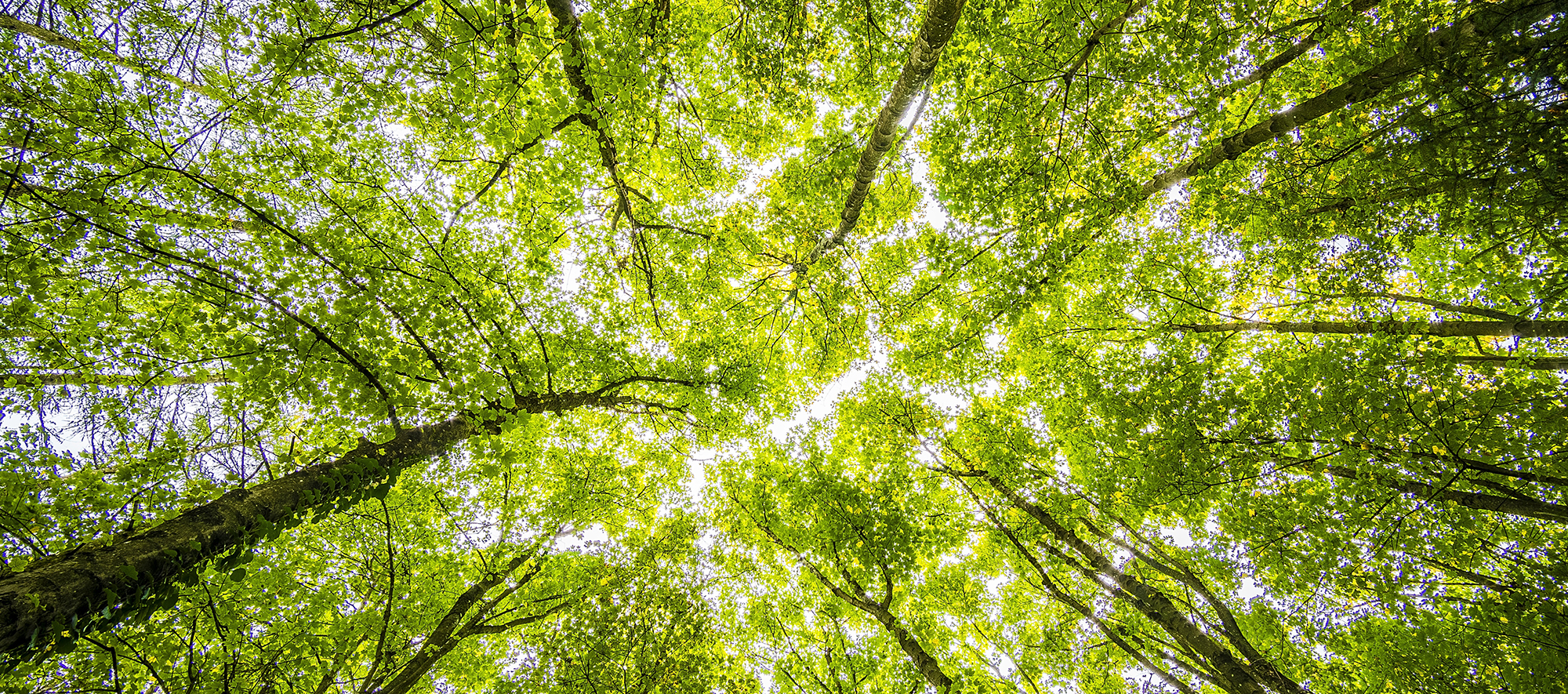
Environmental plastics guide
Eco-friendly packaging
Polybags produces a wide range of eco-friendly packaging that is functional and practical whilst reducing the impact on the environment. As you shop online at Polybags, keep your eye out for the following handy icons for more information about the products you are buying
Biodegradable packaging

An eco-friendly alternative to regular polythene, biodegradable packaging is a term applied to both compostable packaging and bio-additive packaging. You can find out more about each type of packaging in the relevant section, below.
Appears in: Compostable Bags, Compostable Mailing Bags, Compostable Display Bags, Biodegradable Waste Sacks, Biodegradable Mailing Bags, Biodegradable Carrier Bags, Biodegradable Grip Seal Bags, Biodegradable Garment Covers
Compostable packaging

Made from renewable plant-based bioplastics, this packaging disintegrates into environmentally-benign materials in 10-12 weeks in industrial composting conditions (may take longer in home composting).
Appears in: Compostable Bags, Compostable Mailing Bags, Compostable Display Bags, Starch-Based Compostable Bin Liners, Compostable Loose Fill, Compostable Window Bags
Bio-additive packaging

Polythene packaging containing an additive that accelerates degradation, causing products to break down into small fragments before biodegrading into carbon dioxide, water and biomass.
Appears in: Biodegradable Mailing Bags, Biodegradable Carrier Bags, Biodegradable Grip Seal Bags, Clear Biodegradable Bags, Biodegradable Bin Liners, Clear Biodegradable Garment Covers, Biodegradable Stand-Up Pouches
Renewable packaging

Renewable bioplastics - derived from sugars, starches and other natural sources - can be converted into polymers using similar processes to those of traditional polythene but, unlike fossil fuels, the source materials can be replenished after use.
Appears in: Compostable Mailing Bags, Compostable Display Bags, Compostable Packing Bags, Biopaper Stand-Up Pouches
Recycled packaging

Products made either entirely or in part from recycled material, either waste produce collected in-house or from recycled consumer products, to reduce impact on the environment.
Appears in: 100% Recycled Coloured Waste Sacks, 100% Recycled Mailing Bags, 100% Recycled Clear Bags, UK's Best Range of Black Sacks, Recycled Vest Carriers, Wide Plastic Sheeting, Economy Paper Bags, Paper Carrier Bags
Recyclable packaging
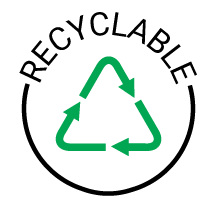
Packaging made from recyclable material, meaning that it can be recycled after use and converted into a new product of the same material, thereby helping to reduce waste and lower greenhouse gas emissions.
Appears in all categories, including: Packing Bags, Grip & Zip Seal Bags, Polythene Rolls, Mailing Bags, Display Bags, Carrier Bags, Waste Bags & Sacks, Bubble Packaging, Eco Packaging
Paper packaging

A widely-recyclable material, paper packaging is a popular alternative to polythene packaging when the functional benefits of plastic are not essential, i.e. strength, flexibility, moisture resistance.
Appears in: Paper Carrier Bags, Paper Mailing Bags, Economy Paper Bags, Colourful Paper Bags, Stand-Up Pouches, Gift Bags, Specialist Waste Sacks
Eco-comparison tool - which packaging is the greenest?
What is the difference between Degradable Plastics and Biodegradable Plastics?
Degradable Plastic is an oil based plastic containing a chemical additive that undergoes significant change in its chemical structure causing large polymer molecules to break down into smaller molecules or particles.
Biodegradable Plastic is a degradable plastic in which the degradation results from the action of naturally occurring microorganisms such as bacteria, fungi, and/or algae.
There are two primary differences between 'degradable' and 'biodegradable'. Firstly, heat, moisture and/or UV exposure most often causes the degradation of a degradable product, whereas microorgganisms degrade a biodegradable product. Secondly, degradable products tend to take much longer to break down into carbon dioxide, biomass and water.
When degradable plastics break down into smaller molecules, eventually they will be small enough to be consumed by microorganisms and so biodegradation occurs. In essence then, all degradable films will eventually biodegrade but at different speeds.
What are my options for Polythene Film?
There are mainly two options available to make normal Polythene into Biodegradable film and these are as detailed below:
Starch based or Biobased (Hydrodegradable)
It is made from corn (maize), potatoes or wheat. This form of biodegradable films meets the ASTM standard (American Standard for Testing materials) and European norm EN13432 for compostability as it degrades at least 60% within 180 days or less.
These materials predominantly require an active microbial environment such as municipal compost before they will degrade. The heat, moisture and aeration one gets in a compost pile are vital to this type of biodegradable film working well.
Pros:
- Degradable & Compostable
- Normally No fossil fuel or very little fossil fuel (some grades have a % mixed with traditional polymer)
- Faster degradation
Cons:
- Poor mechanical strength than additive based example - filling a starch bag with wet leaves and placing curbside can result in the bottom falling out when a hauler picks it up.
- Limited Shelf life and difficult to recycle.
- Some argument over actual energy input as compared to oil based polymers when you consider whole life cycle of growing crop through to raw material production.
- Relatively expensive polymer cost but likely to fall in future as industry develops.
Typical Application area: Municipal/Local authority compost system.
Additive based
Films made out of blending an additive to provide UV/Oxidative and then Biological mechanism to degrade plastics film typically in 6 months to 2 years in a landfill site and/or standard composting system.
In this, biodegradation is a two stage process in which, first the plastic is converted by reaction with oxygen (light, heat and/or stress) to molecular fragments that are water wettable and second, these smaller oxidized molecules are biodegraded. (converted into carbon dioxide, water and biomass by microorganisms)
Pros:
- Cheaper than starch based & Proven technology.
- Controlled degradation.
- Film made out using this look, act and perform just like their non-degradable counterparts, except they break down after being discarded.
- Easier to Recycle.
Cons:
- Made using non-renewable fossil fuel.
- Degradation depends on conditions of heat, light, stress, air etc.
Typical Application area:Rubbish Bags, Compost Bags, Carrier bags, Agricultural Film, Mulch Film.
What is my best environmental and commercial choice of film?
We believe consumers of film need to consider 3 questions in choosing their film:
- What is the cost of the film absolutely and relative to other film options?
- How will film perform its intended function - again absolutely and relative to other film options?
- What will happen to this product once discarded using the intended product? Consider Waste collection and landfill costs, Recycling and Waste-to Energy possibilities
At Polybags we are urging more investment into improved recycling where possible and cost effective re-use of the same film for another purpose rather than 'managing' its degradation. In addition, we believe more research should be put into 'Energy-from-Waste' schemes popular in some other European countries.
Where customers want film that will be put into the waste stream after use and degradation is requested, our current preferred solution is film manufactured using a degrading additive. Film using this technology is currently cheaper, stronger, and more recyclable than starch based film and does offer a reasonable environmental solution to packaging waste.
What future ecopolythene developments are likely?
Whilst we currently offer biodegradable film/bags made using an additive technology, we are researching in films which can degrade in even shorter times using either Starch based technology or Additive based, depending on the relative success of on-going technological developments.
What about recycling instead?
Recycling has always been our top priority to reduce packaging waste particularly associated with plastic film/bags. The key to improvement is collection systems at point of use and sorting/contamination improvements to allow reprocessing.
All in-house scrap within POLYBAGS is recycled and POLYBAGS biodegradable film/bag can be recycled too.
Is paper more environmentally friendly than plastic?
Not according to the weight of evidence.
Lower Shipping Requirements
Since plastic bags are normally much thinner and lighter than comparable paper bags, it would take at least seven 45-foot trucks of paper bags to deliver the quantity of bags contained in one 45-foot truckload of plastic bags. Consequently, the use of plastic bags reduces road traffic, the resulting air pollution, and truck fuel consumption.
More Natural Resource Consumption?
Polyethylene is derived from comparatively small quantities of natural gas. All plastics and chemicals use less than 10% of the total oil and gas produced in this country (most goes into transportation and heating). In contrast, paper is made by destroying trees. Both have an impact on diminishing resources and although fossil fuels are non-renewable future plastics may be made from renewable sources (in the way that we now have managed tree plantations for paper).
Pollution, Environmentally Safe Products:
Plastic bags are an environmentally safe product to produce. The majority of kraft paper is made by heating wood chips under pressure at high temperatures in a chemical solution and paper production generates more air and water pollutants than plastic bags.
Paper is made by pulping wood and other materials in water. The wet material then has to have the water removed. This is done by heat and pressure. The fossil fuel required to drive the water out of one paper bag is more than the amount required to make one plastic bag.
Recycling
It takes less energy to recycle a pound of plastic than it takes to recycle a pound of paper.
Some suggestions to make environmental savings
There's so much we all can do. We just have to do it. Here's my penny's worth:
- Encourage companies to use less unnecessary packaging - and to convert to lighter, thinner packaging (often films!).
- Discourage printed packaging - print involves extra costs, hence energy, and printing inks and solvents create plenty of associated environmental nasties.
- Recycle wherever you can.
- Use your car less, airplanes less, improve house insulation and turn off unneeded lights and equipment - this is where the vast majority of immediate energy saving can be made, often quite easily.
FREE DELIVERY

Bio and 100%-recycled mailing bags in low quantity handypacks.


